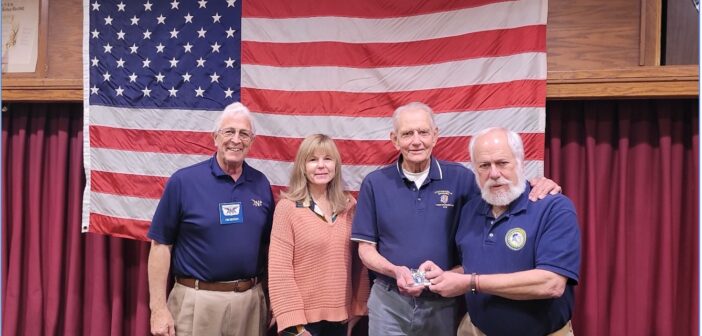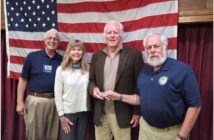 At their January, 2025 meeting, the members and guests of the Grampaw Pettibone Squadron were privileged to have a presentation about a Ling-Tempco-Vought A-7 Mission during the Vietnam War flown by Captain Eric Axel Jensen (USN, Ret.). Eric began his US Navy career as a Seaman Recruit. He progressed to Seaman before transferring to an aviation career as an airman followed by advancement as an ADJ-3 (Jet Engine Mechanic, E-4). In June 1965, he moved into flight training and was commissioned, on August 12, 1966. He began flight training and was introduced to a number of different aircraft, both piston driven and jet. He was transferred to Replacement Training with the LTV A-7A. Between 1969-70, Eric flew 119 combat missions from the USS Coral Sea and USS America. He continued his career in the Navy and was promoted to Captain in 1987 before retiring in 1990.
At their January, 2025 meeting, the members and guests of the Grampaw Pettibone Squadron were privileged to have a presentation about a Ling-Tempco-Vought A-7 Mission during the Vietnam War flown by Captain Eric Axel Jensen (USN, Ret.). Eric began his US Navy career as a Seaman Recruit. He progressed to Seaman before transferring to an aviation career as an airman followed by advancement as an ADJ-3 (Jet Engine Mechanic, E-4). In June 1965, he moved into flight training and was commissioned, on August 12, 1966. He began flight training and was introduced to a number of different aircraft, both piston driven and jet. He was transferred to Replacement Training with the LTV A-7A. Between 1969-70, Eric flew 119 combat missions from the USS Coral Sea and USS America. He continued his career in the Navy and was promoted to Captain in 1987 before retiring in 1990.


Eric’s presentation was a review of one night mission flying with VA-82 Marauders in the single seat, single engine Vought A-7A Corsair II attack aircraft. It was the Navy’s newest work-horse flying the attack mission. He flew from the USS Coral Sea on May 19,1970. Eric started his presentation by explaining that he did not have to set his alarm for an 0200 mission briefing, since his room was directly under the flight deck. He did so anyway. His room was located a few feet below the flight deck and forward, just under the end of the number one catapult. Launches exploded overhead whenever a jet was released. This was followed by the catapult piston slamming to a stop in a few feet with an ear-splitting BOOM! In addition to the constant noise from overhead, his room was not air conditioned and the temperature rose to over 90 degrees F, making sleep almost impossible.
Eric arrived at the squadron Ready Room to be briefed on the day’s mission. He recorded all the essentials needed to fly the mission: launch time, recovery time, weapons type and load, assigned aircraft and emergency recovery time if his only radio fails. All pilots are briefed about their position, the weather, and hostile enemy fire.
As a lieutenant junior grade, Eric was always a wingman. On this particular mission, he was flying with a pilot who was on his second tour. Before deployment, Eric trained with other pilots for a year, practicing virtually every mission type they might be required to fly, utilizing all kinds of ordnance. Based on the mission, adjustments were discussed between crews to identify any specific condition they might encounter and the tactics they would use.
The mission was not scheduled to be a long one, but, after operating all night on this schedule for nineteen straight days, he was tired. Every flight officer, in addition to flying combat, had duties assigned that collectively made the squadron function. He, personally, had five squadron jobs and was on duty an accumulation of four different squadron and ship watches.
Eric explained that the stress of these missions had an impact on everyone. As of that night, the ship had nineteen operational losses, including one pilot from their sister squadron. Aircraft and aircraft crew losses had become almost routine, and he was not prepared for this reality. He tried to insulate himself mentally from the constant emotional pain of these losses. He desperately clung to the belief that it wouldn’t happen to him. He talked himself into believing that if he did not miss the one thing that tried to kill him, he could remain safe. He adhered to these thoughts because when he climbed the ladder into the cockpit, he was alone. He had no one else to depend on. He admitted that his training and experience, in spite of the self-confidence was matched against the mounting losses, making him realize that he was in fact, fallible and only with God’s help could he do the job he was assigned.
Eric shared with the audience his thoughts during the mission briefing. Stress was constant. He absorbed the information from the briefing, recorded the requirements, noted any conditions and factors that would be in the way of a successful flight. Even while considering all the requirements, he admitted that he was scared. Every bit of information regarding crew losses, damaged aircraft and worsening weather all culminated in his mind to make him question his confidence in his ability to complete the mission safely.
After the briefing, Eric suited up with flight and survival gear, stopped by maintenance control to read the aircraft fault history and signed for the airplane he would be flying.
After the mission briefing, he came up to the flight deck to preflight his plane. The flight deck was bathed in pitch black darkness. Waiting for his eyes to adapt to the darkness he slowly made his way to his plane. He walked carefully to avoid tripping over tie-down chains for other aircraft as well as his own. Between the stillness of the night and the thoughts of the target, Eric reminded himself he had a mission to fly.
Stress was constant. Eric admitted that he tried to shut down all feelings, especially fear. He kept busy, and tried to avoid and deny these emotions. He had difficulty dealing with the fear and in desperation he decided to pray.
He conducted a preflight of the aircraft before climbing into the cockpit and preparing for launch. This was followed by engine start and launch preparation. Following directions from the yellow-shirted taxi director, he slowly increased the throttle and moved towards the starboard number one catapult.
Once in place on the catapult, after all checks were completed, Eric saw the catapult officer motion him with his twirling wand in a circular motion to go to full throttle. Moving the throttle forward, he reviewed all gauges in the cockpit and turned his exterior lights on to indicate he and the plane were ready. A moment later a yellow master caution light flashed on. The message displaying on the dash read “ENGINE HOT”. Too late; he was committed. A slight reduction in throttle to reduce the engine temperature was all that was available. As Eric waited, the catapult fired, launching the aircraft into the black-void of the night sky. Taking control of the aircraft, Eric made a shallow right turn to avoid being run over by the 65,000 ton, ship he just launched from.
He had a mission to fly, and as wingman to the flight leader, he followed his instrument settings to link up at the pre-designated place in the distant black night. Once he arrived at the agreed location, both aircraft flew toward their target. To assist them once they arrived near their objective, they were to contact an Air Force C-130, a four-engine turboprop circling over the ground target. This aircraft was equipped with sensors to find the targets on the ground. Frequency changes were made and contact with the C-130 was confirmed.
The C-130 circled the target area below 10,000 feet and the flight lead at 14,000 with Eric at 16,000 feet. The target was located, and while circling over the location, both Eric and his lead agreed on a plan. The C-130 would drop flares on the target and call out corrections after initial bomb drops.
Eric explained that multiple runs were made on the target and corrections for the hits were radioed to him and his lead. After the second run, he pulled off the target and glanced up through his canopy to be greeted with a potential disaster in the making. While traveling at close to 500mph, he saw the outline of the C-130 directly above his path of flight. No time for anything. Grabbing the control stick with both hands and pulling as hard as he could, he was able to maneuver between the wing tip and tail elevator of the lumbering plane above. Confirmed later by the C-130, the pilot was out of position and put both himself and Eric in harm’s way.
Eric released all his bombs and began his return with his lead to the carrier. His mission, along with his lead was part of a larger event. Twenty-two airplanes from the original launch were inbound, returning from their missions. Each aircraft was assigned an altitude, compass bearing and distance from the carrier, to insure, that all aircraft returned safely. Even as the returning aircraft planned their landing, the next group of aircraft were launching.
Eric arrived at a designated point in the dark sky and reported to the ship his fuel remaining. The controller from the ship instructed him where he was to begin flying a circle at a set compass heading and distance behind the ship. He calculated his holding pattern distance, checked altitude, approach speed and inbound time to the carrier. All must be precise to avoid running over an aircraft ahead or becoming a hazard for aircraft behind. As soon as the first plane was instructed to begin their approach, twenty-one other aircraft, at 60 second intervals, planned theirs. The weather had not improved and he was in the monsoon surrounding the carrier and arriving flight.
Fighting the weather, controlling aircraft movement while descending towards the flight deck, Eric reminded himself of his flight training, “Make your first approach your best approach.” He completed his landing checklist. Listening to the final controller’s voice confirming radar contact, his life was now in that man’s hands. Each slight maneuver was in response to his instruction. “One half mile, call the ball” was the last transmission from the controller. As he approached the carrier in the darkness with the rain, a faint glow appeared to define the ship and visual landing area.
Relating his thoughts to the audience, Eric described in detail the emotion of that moment just prior to landing. Managing the adrenalin pumping through his system and the elevated heartbeat, he made small concentrated changes to the aircraft movement. A moment later, the plane slammed onto the deck and the tail hook captured the cable to bring the plane to an abrupt halt. Eric followed the steps he was trained to do and after cable release moved the aircraft to the assigned parking area.
Eric provided summary details of his eight-month tour off the coast of Vietnam. There were one hundred and thirteen combat missions flown, one hundred and forty-two personal day and night carrier landings, twenty fellow shipmates would not return with one member of Eric’s squadron included in that population.
The squadron wishes to thank Eric Jensen for sharing his memories and details of his experience while serving in the U.S. Navy as a combat pilot.

L to R: Tim Brown – GPS Commander, Cindy Macha – GPS Staff, Eric Jensen – Speaker, David Malmad – GPS PAO




